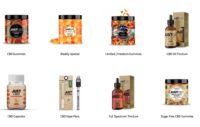Cannabis has always had it tough when it comes to marketing. Part of it is simple logistics. A DTC playbook, heavily contingent on growing a brand’s audience and pushing folks to purchase products through digital marketing, isn’t a possibility for them. Despite its mainstream acceptance, most large ad platforms like Facebook and Instagram won’t touch it because of its tenuous legality. Banner ads don’t convert and only end up on specific platforms like Pornhub or Weedmaps anyway.

And because the legal status changes on a state-by-state basis, it’s extremely difficult for a brand to span across multiple markets. Just think: why would someone living in Florida care about a cool cannabis brand in Detroit if they weren’t in that industry or have ties to that state? This also makes influencer marketing tough because people aren’t finding the coolest people in their respective states to follow. They’re just finding people they think are interesting.
That leaves budtenders – point of sale experts – that hold a huge position of educating and steering folks towards products. Most folks are newer to cannabis – or cannabis has grown up a ton since their past casual experience with it. Budtenders offer an informative, hyper-local solution with extremely limited reach to a narrow market.
But the future shows promise. A new wave of platform marketing has emerged with new formats and lots of room to cultivate and grow for cannabis brands. With a little understanding of what’s driving the success of social media newcomers and evolving mainstays, cannabis companies can potentially find new avenues for marketing and brand-building success.
Going Native
There’s currently a lot of opportunity through the larger cannabis retail and native ordering apps – ones like Weedmaps, Leafly and others that have widespread brand recognition within the cannabis community and a growing array of social media-like features. These are places that already segment according to markets, with a built-in, educated audience open to creative approaches to branding and marketing.
 These types of apps are also becoming the norm more and more. Especially since the pandemic, dispensaries are doing most of their volume through online orders and pickup. As a result, making sure you show up, look great and convey your unique position on these platforms is incredibly important.
These types of apps are also becoming the norm more and more. Especially since the pandemic, dispensaries are doing most of their volume through online orders and pickup. As a result, making sure you show up, look great and convey your unique position on these platforms is incredibly important.
Listening and Learning
Whether it’s Clubhouse or other upcoming rivals on the horizon, audio platforms are great because they can serve as a means to have an honest, direct and enlightening conversation about cannabis. This is great news for budtenders who can help a brand expand their reach by facilitating these sorts of conversational consumer relationships. As the cannabis market matures rapidly, people will need a safe place to normalize consumption, talk about dosage or about how normal consumers (not just stereotypical potheads, but every day, “constructive members of society”), are able to use cannabis effectively in their day-to-day lives.
A lot of other visually-based platforms are about curation or presentation of an ideal life and less about learning or sharing – a place where audio platforms can shine.
Old is New
In some cases, it’s not about just using new platforms but finding better ways to utilize old ones. For example, legal or not, a lot of folks are about discretion when it comes to their cannabis. They want to get questions answered and learn about brands and products via peers and experts, but they don’t want their bosses or grandparents knowing that they’re hitting a pen between meetings or before brunch.
 That’s why time-based content platforms – Snapchat, Instagram, WhatsApp and others – that offer individuals and brands some measure of safety, as well as controlled messaging, will help continue to normalize cannabis.
That’s why time-based content platforms – Snapchat, Instagram, WhatsApp and others – that offer individuals and brands some measure of safety, as well as controlled messaging, will help continue to normalize cannabis.
Another non-cannabis example worth emulating is Psilodelic, a psilocybin gummy brand that’s super low-dose and decently branded, using Instagram in a creative way. Purposefully making their accounts private and going without a public hub, the only way to buy the product is to follow and DM them. “Hacking” the platform in this way means they have to shut down and open up new accounts all the time, but they’ve done an amazing job offering a product that, similarly to cannabis, is sometimes inaccessible, and have done it in a way that’s simple and feels more elite. That’s creative entrepreneurship.
In the end, using these changing platforms means approaching them as tools to foster a better relationship with people. The brands that succeed will have dead-simple instructions and information that really helps to empower folks to look at cannabis in a different way. Then, as we finally reach legalization, these brands will find themselves better equipped to step into the mainstream, confident in the meaningful relationships they’ve already cultivated.


















